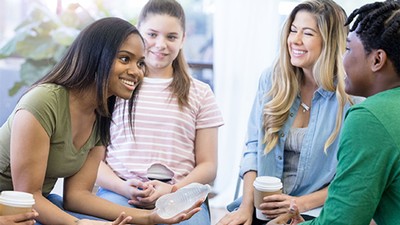Best Buddies' bridges campus disability divide
Best Buddies' bridges campus disability divide
From Hard News Cafe 10/23/03
He has all the moves down. The wrist flicks, the hat tipping, the attitude, even the elusive moonwalk are all easily maneuvered for him. His friends gather around to watch as he dances. He is not Michael Jackson. His name is Branon Frederickson and he has Down syndrome.
One of Frederickson's newest friends, Sara Whitehead, a Utah State University senior, chuckled as she recounted his imitation of the King of Pop.
"He has rhythm like no one I've ever seen," Whitehead said. "He doesn't just think Michael Jackson's cool. He can dance just like Michael Jackson."
Whitehead and Frederickson were brought together for the first time this semester at the opening social of the USU chapter of Best Buddies, an international organization that pairs college students with intellectually disabled members of the community.
Best Buddies is one of the world's largest and farthest-reaching non-profit organizations dedicated to helping the intellectually disabled. With nearly 50,000 volunteers this year in more than 1,000 middle schools, high schools and college campuses in nearly a dozen countries, Best Buddies estimates that its volunteers contribute nearly $52 million of service each year.
According to its mission statement, Best Buddies' goal is simple. It is "dedicated to enhancing the lives of people with intellectual disabilities" and, largely, it accomplishes this by making "one-on-one friendships."
The college students who volunteer their time are called "college buddies." While there are several different types of Best Buddies programs, the College Buddies program is present on 316 campuses worldwide.
Each college buddy makes a commitment to contact their buddy on a weekly basis (by phone, e-mail, mail, or in-person), go on two outings each month and attend chapter meetings. In addition, group outings are planned once a month with the entire chapter.
Brittany Pulley, membership coordinator for the USU chapter of Best Buddies--which is funded by the Val R. Christensen Service Center--said that the buddies can tell when someone wants to spend time with them and they respond well to genuine friendship.
"For a lot of kids in Best Buddies, we're the only friends they have," Pulley said. "It's a good program for them."
The USU chapter, headed by Justin Haskell, has 50 full-fledged college buddies this year. According to Pulley, there were over 70 applications submitted to the organization, but some had to be turned away or made associate buddies that could team up with a buddy or simply attend the group outings.
"It was hard to pick the 50, but we needed the best of the best," Pulley said.
McKenzie Catten, a USU junior, was one of the 50 selected to become a college buddy, although she was unsure of being part of the organization to begin with.
"I didn't know how I'd react to being with someone who had a mental disability because I'd never been around them before," Catten said.
Pulley, who has spent much of her life around the mentally disabled, eventually convinced Catten to go to one of the introductory meetings. Catten soon changed her mind and applied to be a part of the program.
"I felt like I could help someone just by being a friend," Catten said.
Much of that help simply comes from the socialization aspect of Best Buddies, Pulley said. Sometimes a buddy will say or do something inappropriate in public and the college buddy is there to let them know what may not be socially acceptable.
"They're more willing to take what their buddy tells them," Pulley said. "If your friend told you, 'you really shouldn't talk like that,' you'd be like, 'oh, OK.' You really do care what your friends say."
According to the American Association on Mental Retardation, "Providing individualized supports can improve personal functioning, promote self-determination and societal inclusion, and improve the personal well-being of a person with mental retardation."
Best Buddies believes it helps to provide some of those supports which help people with mental disabilities become more independent and included in society.
Pulley's buddy, Melissa, for instance, used to be talkative but has now become somewhat shy in big groups.
"My goal, this year, is to help her get out of her shell," Pulley said.
Pulley hopes to accomplish this goal, in part, through hip-hop dance, which she and her buddy share as an interest.
Best Buddies is not just beneficial to those with mental disabilities, however. Whitehead, Pulley, and Catten each said they expect to be taking something with them from their experiences in the program.
"There's something about their innocence--their child-like qualities--that makes you feel good, makes you want to be around them and learn from them," Catten said. "I'm learning a lot more from her than I think she can ever learn from me."
Pulley pointed out the importance of both buddies getting something good out of Best Buddies relationship.
"If you're not getting something out of the program, there's a 100 percent chance your buddy's not getting anything out of the program," Pulley said.
For more information on other Best Buddies programs, mental disabilities, or other ways to help those with disabilities, please visit the following sites:
American Association on Mental Retardation
The Joseph P. Kennedy, Jr. Foundation
Special Olympics International
By Brant Christiansen
Comments and questions regarding this article may be directed to the contact person listed on this page.





